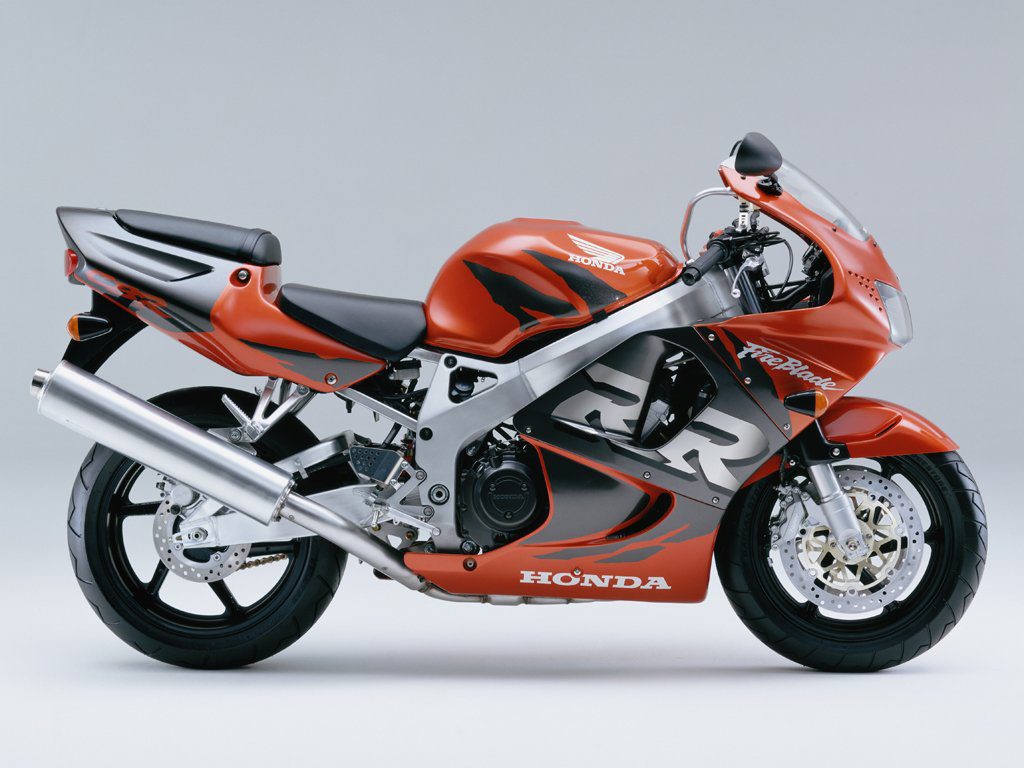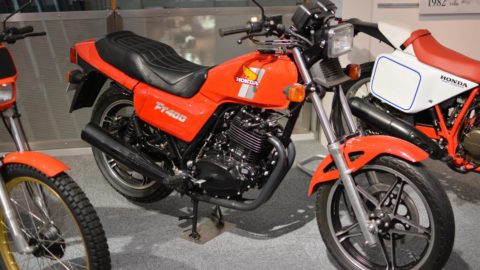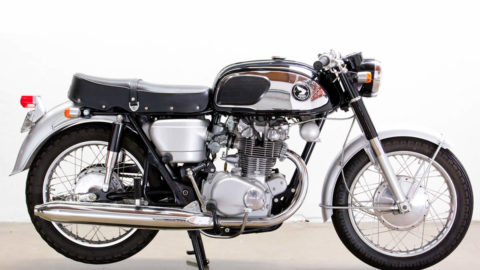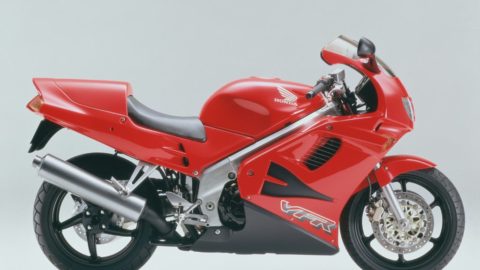The Nineties

Honda CBR 900 RRW Fireblade 1998
This was the decade of the race replica, no doubt about that! The fundamental survival route was minimal mass and maximum power crafted in a way that made the handling way ahead of any of the old superbikes. Exemplified by the Honda CBR900, a bike so radical and advanced in 1992 that it managed to remain fundamentally unchanged and unchallenged until the Yamaha R1 turned up last year – the Honda still beat it in the sales game by undercutting its price, the research and development costs long paid off.
Honda’s CBR600 also remained dominant, though heavily challenged by the Kawasaki ZXR600 – merely a question of rider’s preference as to style, colour and riding position; they are so close in abilities. Calling either bike good’s something of a massive understatement.

Suzuki GSX600 (1994)
Suzuki made a lot of mediocre machines – GSX600F, etc – that can certainly be classed as ugly if not bad. The GSXR series lost the plot – high power and low mass – often handled strangely but retained tough motors that were shown off best in street fighter style. The watercooled versions of the GSXR 750 and 1100 offered loads of kicks, especially if you were into Russian Roulette – most frightening bikes of the decade? Certainly the most uncomfortable.
Suzuki redeveloped the GSXR’s into the 750 SRAD, a well wired motorcycle that would, with maximum effort and concentration, do for the CBR900. But it was a ten-tenths kind of machine with no softer edge, no chance to relax and none of the Honda’s surprising versatility. The GSXR750 makes it as cafe racer of the decade, for whatever that’s worth!
Before the CBR900 made its play, the Yamaha FZR1000 EXUP was considered the main machine for serious speed merchants, having most of the GSXR’s kicks but handling, thanks to the Deltabox frame, in a far more predictable manner. Even the lighter Thunderace failed to dent the CBR’s popularity. Yamaha had to completely reinvent their design in the form of the excellent R1, though its riding position and general demeanour is less graceful than the defining CBR’s (itself no comforter of those afflicted with piles).
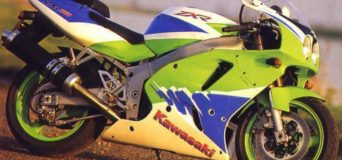
Kawasaki ZXR750L (1993)
Kawasaki tried very hard with the ZX-9R and ZXR750 but had major problems paring down the weight and never seemed to get the suspension quite right, though they were never as plain dangerous as the ZX-10 on wet roads! The ZZR1100 started out as the fastest bike of the decade and kept up its engine development until overwhelmed by the Honda Blackbird, both so excessive in mass that they really belong to the eighties rather than the nineties!
The massive influx of grey imports, new and used, had an effect on the replica scene – loads of madly screaming 250’s and 400’s. The CBR400 the best of the bunch although the Kawa ZXR400 came a close second, even if only because of its howling exhaust and exuberant revs! The VFR400 was better yet, save that a few blew up with no warning whatsoever; an expensive indulgence.
The RGV and TZR 250’s were the only strokers of note, the engines being somewhat tougher and easier running than the earlier versions but didn’t really offer any benefits over the four stroke fours, so finely honed and well developed were they. The TZR250R was, perhaps the best of the bunch; at least to begin with, Suzuki putting more effort into the RGV250’s development – they proved popular with the more extreme replica riders. So give the RGV the nod as the best stroker of the decade.
The amount of effort needed to develop competitive new replicas was incredible in terms of money, expertise and manpower. Thus it was often easier to reinvent an old design, whose development costs had long been paid off. Kawasaki tried hard with their Zephyr range but the absurd underdevelopment of their engines was something few could countenance even if they had a passing style. Tough enough, but just a little bit sick-making, don’t you know.
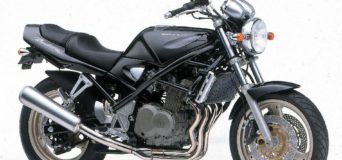
Suzuki GSF400 Bandit (1991)
Suzuki, having failed to sell many GSX engined machines in fanciful plastic, went the naked route with a couple of Bandits, 600 and 1200 – don’t know if you’d call them seventies or eighties retro – their most distinctive feature, an otherwise rarity at the time, competitive pricing. Overnight, a whole range of Japanese UJM’s were made redundant by the Bandits combination of good performance, adequate handling and crafty pricing. The 600 Bandit, in particular, did extremely well in terms of sales.
Arguably, the big CB1000N or the later XJR1200 were more interesting retro’s but so large was the price difference that few had any time for them. The CB1000N was an odd version of the CBR1000, a bike that suffered in general comparison to the 600 CBR. The XJR was descended from the old XS1100, so had some credibility, even if in the decade and half between these models the XS had mutated into the FJ1100/1200 – both splendid renditions of the UJM that, alas, suffered from a severe excess of mass. The Zephyr 1100 was another alternative with a lot of ancient history behind it but its performance was so muted that Z1 owners had to hang their heads in shame. Sorry, but the whole heap of them are bad, on the back of their weight problems.
Honda, who’d done so well with their 600 and 900 creations, didn’t quite hit the pace with their vertical twin CB500, all the more odd insofar as they invented the breed in the sixties (as they did the across the frame four). The CB was a sensible, reasonably rendered piece of motorcycle engineering that was far better than their previous dire Superdream era designs – CB350S and CB450S – but the market had moved on a way and devices like the GPZ500S ruled the vertical twin roost.

Yamaha TDM850 (1993)
Not to forget the rather strange Yamaha TDM850, closely related to the ugliest bike of the decade – the XTZ750. A big old piece of vertical twin engineering, slanted forward and hosted in a Deltabox style frame. Prodigious torque that put a Commando to shame, the engine was fundamentally ill-conceived – separate oil tank, pistons moving up and down together with a complex balancer… come on, pass the sick bucket. Didn’t stop the Yamaha going like stink, especially when fitted with an aftermarket exhaust. Another bike that was good, bad and ugly.
The TDM became the TRX, a weird crankshaft throw that helped it imitate the note of a Ducati vee-twin whose trellis-type frame it had pinched. Not a bad motorcycle, as such, but one woefully overpriced, that offered few advantages over the replica fours. Though rideable and fun, its whole ethos left a bad taste in the mouth, so write it down as bad and ugly!
Yamaha’s other ill-considered oddity of the decade, the SZR660. The fundamentals of a modern thumper, extremely low mass and simplicity of chassis, were entirely missing, pushing the trail based thumper to the brink of instant sales obscurity. Even the trailster XTZ660 didn’t really make the grade in comparison to the XT600E, which took big thumpers of a conventional nature about as far as they were going to go.

The neatest thumper of the decade, the Kawasaki KLX250, which managed to make the most of its 30 horses thanks to a relatively low mass. The KLX650 was also of note because of the sheer effrontery of its torque though in the end it had to fight too much vibration via its balancer to really deliver a good balance of qualities. The latest Jap thumpers are playing with about 40 horses, 250lbs of mass and around 400cc – something to look forward to in the coming years.


